ARRIS Global A5520N A5520N Home Network Interface System User Manual install guide 5111
Pace Micro Technology plc A5520N Home Network Interface System install guide 5111
Contents
- 1. Manual 1
- 2. Manual 2
Manual 2

INSTALLATIONGUIDE
A5500Gateway
© 2012 Pace plc. All rights reserved.
Pace and the Pace logo are registered trademarks of Pace plc. All other trademarks are the property of their respective owners.
Pace provides no warranty with regard to this manual, the software, or other information contained herein, and hereby expressly
disclaims any implied warranties of merchantability or fitness for any particular purpose with regard to this manual, the software, or
such other information, in no event shall Pace be liable for any incidental, consequential, or special damages, whether based on tort,
contract, or otherwise, arising out of or in connection with this manual, the software, or other information contained herein or the use
thereof.
02212012
5100-001094-000
3
Contents
Chapter 1 Introduction. . . . . . . . . . . . . . . . . . . . . . . . . . . . . . . . 4
Gathering items for installation . . . . . . . . . . . . . . . . . . . . . . . . . . . . . . . . . . . . . . . . . . . . . . . . . . . . 5
Finding a suitable location . . . . . . . . . . . . . . . . . . . . . . . . . . . . . . . . . . . . . . . . . . . . . . . . . . . . . . . . 5
Chapter 2 Installing your gateway . . . . . . . . . . . . . . . . . . . . . . . 6
Connecting the power adapter. . . . . . . . . . . . . . . . . . . . . . . . . . . . . . . . . . . . . . . . . . . . . . . . . . . . . 6
Connecting the broadband interface through the Ethernet port. . . . . . . . . . . . . . . . . . . . . . . . . . . . 7
Connecting the broadband interface through the DSL port . . . . . . . . . . . . . . . . . . . . . . . . . . . . . . . 8
Connecting computers to your gateway. . . . . . . . . . . . . . . . . . . . . . . . . . . . . . . . . . . . . . . . . . . . . . 9
Connecting devices using a wired connection . . . . . . . . . . . . . . . . . . . . . . . . . . . . . . . . . . . . . . 9
Connecting devices using a wireless connection. . . . . . . . . . . . . . . . . . . . . . . . . . . . . . . . . . . 10
Connecting phones . . . . . . . . . . . . . . . . . . . . . . . . . . . . . . . . . . . . . . . . . . . . . . . . . . . . . . . . . . . . 11
Connecting an IPTV set-top box . . . . . . . . . . . . . . . . . . . . . . . . . . . . . . . . . . . . . . . . . . . . . . . . . . 12
Configuring the gateway . . . . . . . . . . . . . . . . . . . . . . . . . . . . . . . . . . . . . . . . . . . . . . . . . . . . . . . . 13
Chapter 3 Troubleshooting . . . . . . . . . . . . . . . . . . . . . . . . . . . 14
Connection issues . . . . . . . . . . . . . . . . . . . . . . . . . . . . . . . . . . . . . . . . . . . . . . . . . . . . . . . . . . . . . 14
LAN issues. . . . . . . . . . . . . . . . . . . . . . . . . . . . . . . . . . . . . . . . . . . . . . . . . . . . . . . . . . . . . . . . . . . 15
Voice issues. . . . . . . . . . . . . . . . . . . . . . . . . . . . . . . . . . . . . . . . . . . . . . . . . . . . . . . . . . . . . . . . . . 16
Appendix A Regulatory and Safety Information . . . . . . . . . . . 17
Declaration of conformity . . . . . . . . . . . . . . . . . . . . . . . . . . . . . . . . . . . . . . . . . . . . . . . . . . . . . . . . 17
FCC/Industry Canada compliance . . . . . . . . . . . . . . . . . . . . . . . . . . . . . . . . . . . . . . . . . . . . . . 17
Part 15 of FCC rules . . . . . . . . . . . . . . . . . . . . . . . . . . . . . . . . . . . . . . . . . . . . . . . . . . . . . . . . 17
TIA 968 (Part 68 of FCC rules)/IC CS-03. . . . . . . . . . . . . . . . . . . . . . . . . . . . . . . . . . . . . . . . . 18
MPE/SAR/RF exposure information. . . . . . . . . . . . . . . . . . . . . . . . . . . . . . . . . . . . . . . . . . . . . 19
Safety information . . . . . . . . . . . . . . . . . . . . . . . . . . . . . . . . . . . . . . . . . . . . . . . . . . . . . . . . . . . . . 19
AC adapter . . . . . . . . . . . . . . . . . . . . . . . . . . . . . . . . . . . . . . . . . . . . . . . . . . . . . . . . . . . . . . . . 19
Telecommunication cord . . . . . . . . . . . . . . . . . . . . . . . . . . . . . . . . . . . . . . . . . . . . . . . . . . . . . 20
Internal telephone ports (VoIP) . . . . . . . . . . . . . . . . . . . . . . . . . . . . . . . . . . . . . . . . . . . . . . . . 20
Repairs. . . . . . . . . . . . . . . . . . . . . . . . . . . . . . . . . . . . . . . . . . . . . . . . . . . . . . . . . . . . . . . . . . . 20
Location – electrical considerations . . . . . . . . . . . . . . . . . . . . . . . . . . . . . . . . . . . . . . . . . . . . . 20
Location – environmental considerations. . . . . . . . . . . . . . . . . . . . . . . . . . . . . . . . . . . . . . . . . 20
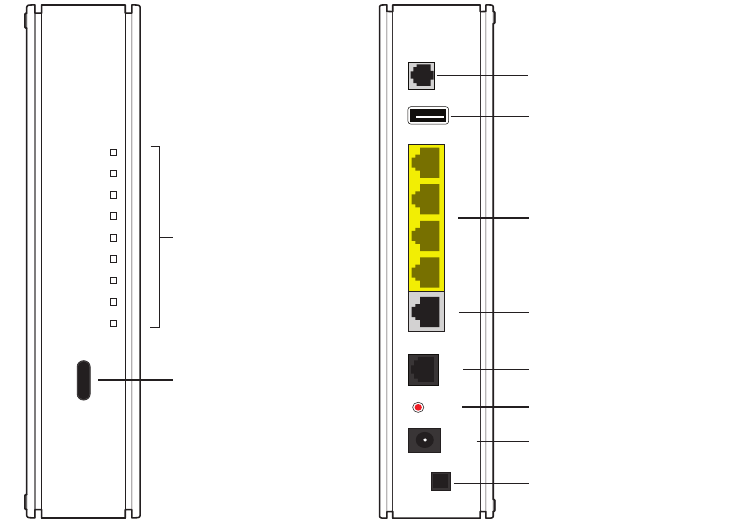
4 Chapter 1 Introduction
Introduction 1
Your A5500 gateway is an advanced networking device that can be installed by you or
your service provider. This all-in-one device includes the modem, router, wireless
access point, firewall, and voice gateway.
Your gateway supports ADSL, ADSL2, and ADSL2+ technology. It has four wired
Ethernet ports, 802.11b/g/n wireless networking, and voice capabilities.
Use WPS (Wi-Fi Protected Setup) to simplify the process of connecting wireless
devices to the network. For more information, go to your gateway configuration page
at http://192.168.1.254
INTERNET
BROADBAND
IPTV
VOICE 2
ETHERNET
WIRELESS
WPS
VOICE 1
POWER
W
P
S
USB
LAN
1
2
3
4
W
A
N
DSL
FXS
1&2
RESET
POWER
1/0
Status
Indicators
DSL broadband port
USB port
Ethernet ports
Ethernet broadband port
Phone line port
Reset button
Power port
Standby button
WPS button
Chapter 1 Introduction 5
Gathering items for installation
To install your gateway, you will need:
•Gateway
•Power adapter
•DSL cable
•Ethernet cables (optional), to connect your gateway to the Broadband interface or
a computer directly to your gateway using a wired connection
•Phone cable (optional), for connecting voice telephone service
•Gateway stand (optional), for installing your gateway vertically
•DSL filter (optional), for each phone on the same line as your gateway
•Voice line splitter (optional), for connecting two phones to the FXS port (voice) of
your gateway
Finding a suitable location
Before you install your gateway, find an appropriate location for it. Set up your
gateway near the main computer or any other device that will connect to it through the
wired Ethernet ports.
Your gateway also serves as a wireless access point. Wireless signals are affected by
many items in homes and offices. Consider the following while determining the
location of your gateway:
•Place your gateway at least 5 ft (1.5 m) from cordless phones, microwave ovens,
or other electronic devices to avoid potential interference, and at least 6 in (15 cm)
from your television to avoid audio hissing or static.
•Place your gateway in an open area to minimize interference from its
surroundings. Wireless signal strength is much stronger in an open area than an
area with obstructions. In a single-story building, place your gateway as high and
as close to each wireless device as possible.
•Keep your gateway away from large metal objects. Metal objects can reflect or
obstruct signals, which can negatively impact wireless signal quality.
•Keep your gateway away from water sources like water coolers or aquariums.
Note: We recommend that you use the included stand to install your gateway
vertically. This prevents you from stacking things on top of it, which can block vents
and cause your gateway to overheat.
6 Chapter 2 Installing your gateway
Installing your gateway 2
Use the information in this chapter to connect your gateway to the Internet and to your
home network.
To install the gateway, complete the following steps:
1. “Connecting the power adapter” on page 6
2. “Connecting the broadband interface through the Ethernet port” on page 7
3. “Connecting the broadband interface through the DSL port” on page 8
4. “Connecting computers to your gateway” on page 9
5. “Connecting phones” on page 11
6. “Connecting an IPTV set-top box” on page 12
7. “Configuring the gateway” on page 13
Connecting the power adapter
The power adapter supplies power to your gateway. Always use the power adapter
that was packaged with your gateway because it matches the power requirements of
your gateway and it complies with local requirements.
1. Connect one end of the power adapter to the power port on your gateway.
2. Connect the other end of the cable to an electrical outlet.
After your gateway is powered on, the POWER indicator blinks green for a moment
and then turns steady green.
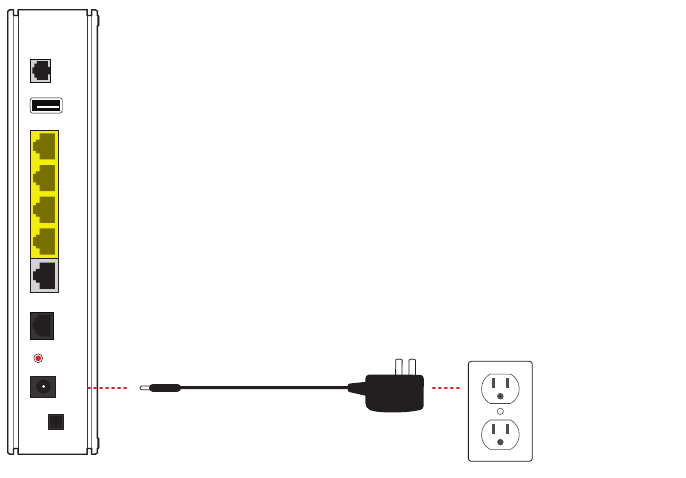
Chapter 2 Installing your gateway 7
Connecting the broadband interface through
the Ethernet port
To connect your gateway to a RJ-45 jack of your broadband router or Ethernet wall
socket:
1. Connect one end of the blue Ethernet cable to the Ethernet port (labelled WAN) on
your gateway.
2. Connect the other end of the Ethernet cable to your broadband router or Ethernet
wall socket.
After your gateway recognizes the connection, the BROADBAND indicator on the
front panel blinks green for a few seconds and then turns steady green.
Power outlet
Power
adapter
USB
LAN
1
2
3
4
W
A
N
DSL
FXS
1&2
RESET
POWER
1/0
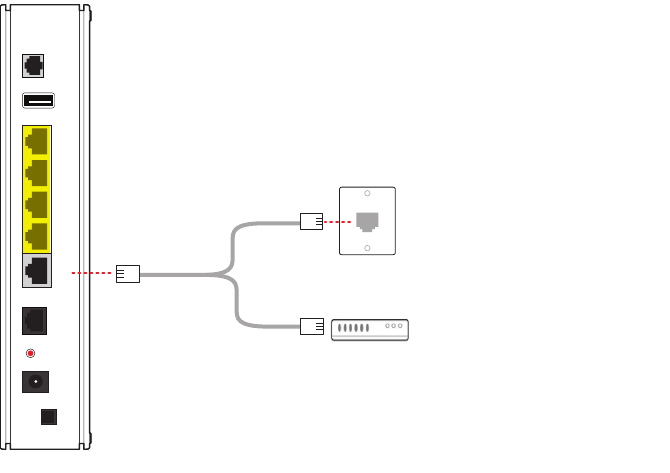
8 Chapter 2 Installing your gateway
Connecting the broadband interface through
the DSL port
To connect your gateway to a Asymmetric Digital Subscriber Line (ADSL) wall jack:
1. Connect one end of the phone cable/twisted pair cable to the DSL port on your
gateway.
2. Connect the other end of the cable to the DSL port of the DSL filter, which must be
plugged into the ADSL-enabled wall jack outlet.
After your gateway recognizes the connection, the BROADBAND indicator blinks
green for a few seconds and then turns steady green.
Wall Ethernet
socket
USB
LAN
1
2
3
4
W
A
N
DSL
FXS
1&2
RESET
POWER
1/0
Broadband
router
or
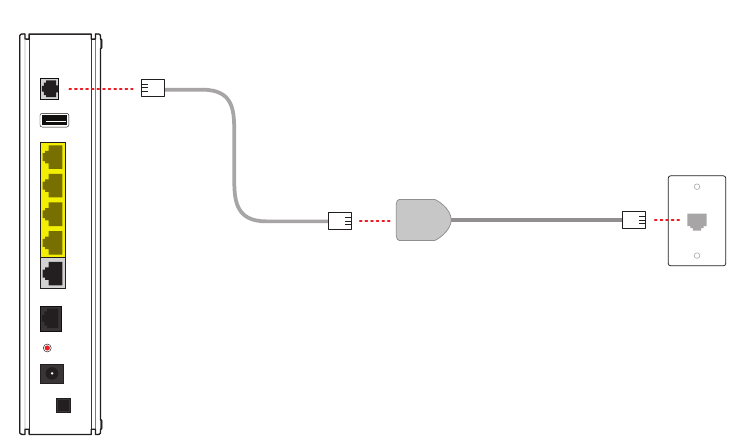
Chapter 2 Installing your gateway 9
Connecting computers to your gateway
You can connect your computers and devices to your gateway using a wired
connection or a wireless connection. With either type of connection, you can use the
first computer that you connect to the network to set up your gateway.
Connecting devices using a wired connection
Your gateway has four wired Ethernet ports that you can use to connect computers or
other devices.
1. Connect one end of the yellow Ethernet cable to one of the yellow Ethernet ports
on the gateway.
2. Connect the other end of the cable to the Ethernet port on your computer.
You can connect up to 4 computers to your gateway using the wired Ethernet ports.
Note: A 6-foot yellow Ethernet cable is provided with the gateway. If you need an
additional or longer cable, use a Cat 5 or Cat 5e Ethernet cable.
After your gateway recognizes your computer, the ETHERNET indicator turns steady
green, and blinks when your computer starts communicating with your gateway.
USB
LAN
1
2
3
4
W
A
N
DSL
FXS
1&2
RESET
POWER
1/0
Phone
socket
Phone
cable
DSL
filter
Phone line
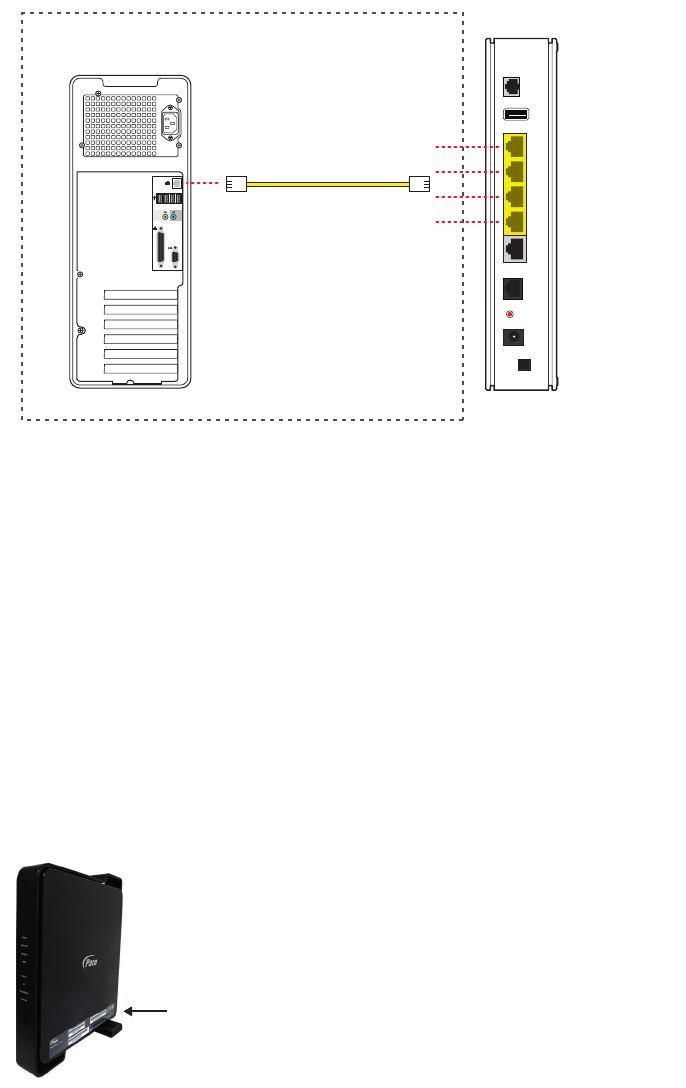
10 Chapter 2 Installing your gateway
Connecting devices using a wireless connection
Your gateway has an integrated wireless access point that you can use to connect
wireless devices to your gateway. By default, your gateway is configured with a
network name (SSID) and WPA-PSK/WPA2-PSK security.
1. On the wireless device, view the available wireless networks. The specifics of how
you do this depend on the device you are connecting.
The default network name (SSID) and the encryption key (64-bit hex) are printed
on the label on the bottom right side of your gateway. Mac OS X users might have
to enter the “$” character at the beginning of the encryption key.
2. Select the appropriate network name and connect.
3. At the prompt, enter the encryption key.
USB
LAN
1
2
3
4
W
A
N
DSL
FXS
1&2
RESET
POWER
1/0
Ethernet
cable
Computer
Not required for wireless setup
Location of the label
containing the SSID
and WiFi key
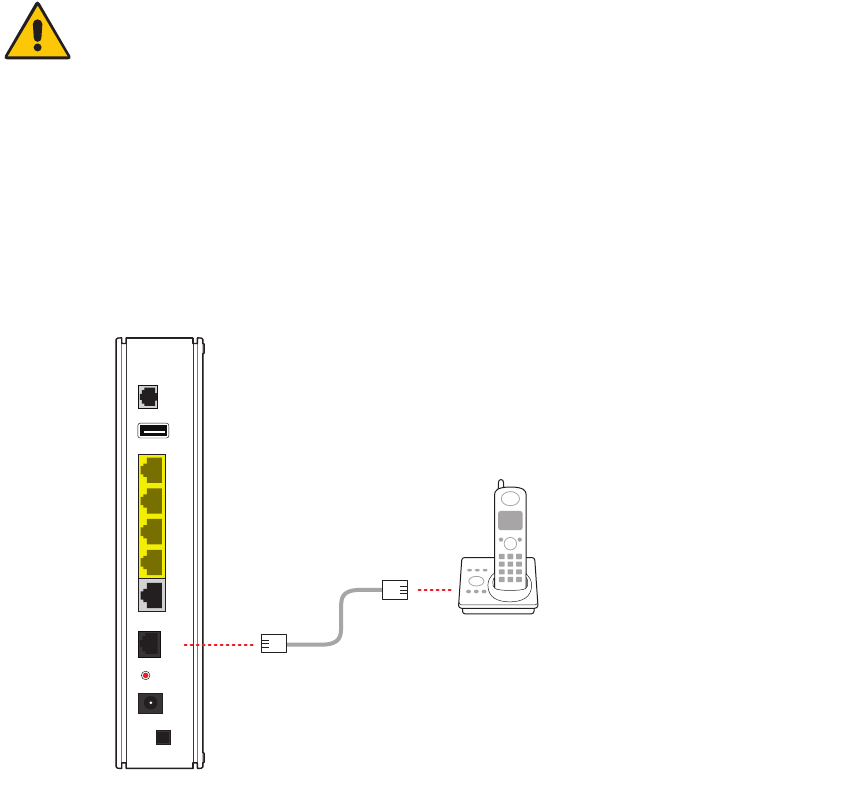
Chapter 2 Installing your gateway 11
After your gateway recognizes the wireless device, the WIRELESS indicator turns
steady green, and blinks when the wireless device starts communicating with your
gateway.
You can use WPS (Wi-Fi Protected Setup) to simplify the process of connecting
wireless devices to the network. For more information, go to the gateway configuration
page at http://192.168.1.254
Connecting phones
The gateway includes one RJ-14 port (Phone 1 & 2) with the capacity to support 2
phone lines using a splitter or multi-jack adapter.
WARNING: Do not connect the VoIP lines to your current home telephone wiring,
especially if your home has an alarm system. Ensure that you are subscribed to VoIP
service before configuring VoIP on the gateway.
1. Connect one end of the phone cable to the gray FXS 1 & 2 port on your gateway.
2. Do one of the following:
•For one phone, connect the phone cable directly to the telephone.
•For two phones, connect the phone cable to a splitter and then to the
telephones.
USB
LAN
1
2
3
4
W
A
N
DSL
FXS
1&2
RESET
POWER
1/0
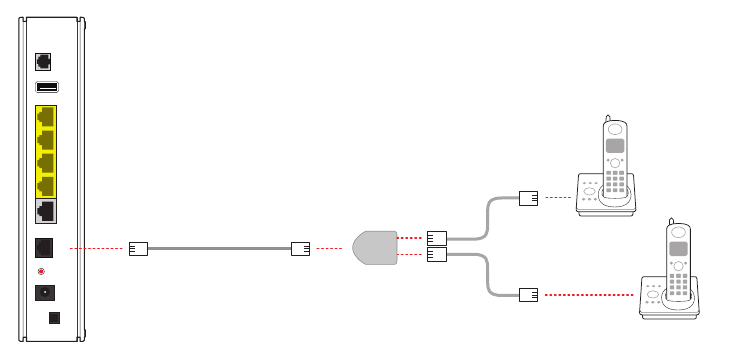
12 Chapter 2 Installing your gateway
After your gateway recognizes the phones (Line 1 and Line 2), the VOICE 1 and
VOICE 2 indicators turn steady green and blink when the associated phone is active.
Connecting an IPTV set-top box
Your gateway can be configured to use IPTV services through the Ethernet port.
To connect your gateway and set-top box:
1. Connect one end of the Ethernet cable to one of the yellow Ethernet ports on your
gateway.
2. Connect the other end of the cable to the Ethernet port of your set-top box.
After your gateway recognizes your set-top box, the ETHERNET indicator turns
steady green, and blinks when your computer starts communicating with your set-top
box.
USB
LAN
1
2
3
4
W
A
N
DSL
FXS
1&2
RESET
POWER
1/0
Telephone
cable FXS phone
splitter
Two phones
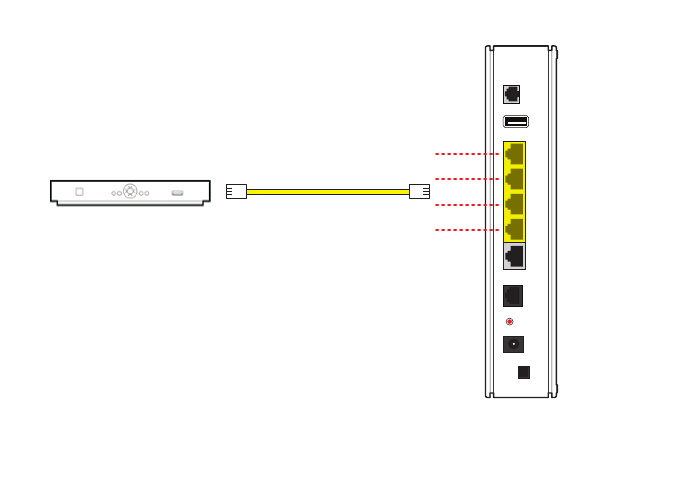
Chapter 2 Installing your gateway 13
Configuring the gateway
If necessary, you can use the gateway configuration page to view or change the
gateway settings.
On a computer connected to your gateway, enter the following into the address bar of
a Web browser: http://192.168.1.254
USB
LAN
1
2
3
4
W
A
N
DSL
FXS
1&2
RESET
POWER
1/0
Ethernet
cable
IPTV set-top box
14 Chapter 3 Troubleshooting
Troubleshooting 3
This chapter provides information about common gateway installation issues. If an
issue has more than one potential cause, the most common cause is listed first.
Connection issues
Use the information in this section to identify and resolve issues related to
connectivity.
The POWER indicator is not on
•The power cable may be loose or disconnected. Check the power cable to ensure
that the cable is securely connected. If the power cable is plugged in to a power
strip or switched outlet, ensure that it is on. Ensure that you are using the power
supply that came with your gateway.
•The power supply may be faulty. Verify that the light on the power supply is green.
•The AC outlet may be faulty. Try plugging your gateway in to a known good outlet.
The POWER indicator blinks immediately after the device starts, and then turns
steady green
•The POWER indicator blinks during POST (Power on self-test). This is normal
behavior.
The POWER indicator is red
•The POST (Power on self-test) may have failed. Press the RESET button and hold
it for 10 seconds to reset your gateway.
The BROADBAND indicator blinks
•The Ethernet or DSL cable may be loose or disconnected. Check the connections
to ensure that the cable is securely connected.
•The DSL connection may not be established. Press the RESET button and hold it
for 10 seconds to reset your gateway. If resetting your gateway does not fix the
problem, contact your service provider.
Chapter 3 Troubleshooting 15
The BROADBAND indicator blinks green for a long time, then turns red
•Your gateway may have failed to synchronize with the service provider network.
Check the connections to ensure that the cable is securely connected.
•Your Internet service may not be activated. Contact your Internet service provider.
The INTERNET indicator blinks
•Your Internet service may not be activated. Contact your service provider.
The INTERNET indicator is red
•The user name and password may have been entered incorrectly. Verify the user
name and password on the gateway configuration page, and try again.
•Your Internet service may not be activated. Contact your service provider.
The ETHERNET indicator is not on
•The Ethernet cable may be loose or disconnected. Check the connections to
ensure that the cable is securely connected.
The WIRELESS indicator is not on
•No devices on your home network are currently connected to your gateway over
the wireless connection.
•Ensure that the wireless feature is enabled. For more information, go to the
gateway configuration page at http://192.168.1.254
The Internet is not accessible but the gateway configuration page is accessible
•The Ethernet or DSL cable may be loose or disconnected. Check the connections
to ensure that the cable is securely connected.
LAN issues
Use the information in this section to identify and resolve issues related to the home
network.
Can’t connect to your gateway through the Ethernet port
•The Ethernet cable may be loose or disconnected. Check the connections to
ensure that the cable is securely connected. The ETHERNET indicator blinks
green when there is a working link to a device.
A wireless device cannot get an IP address
•The device may not be set up with the appropriate security type or security key.
Ensure that the wireless device is using the appropriate credentials.
•The wireless device and your gateway may be using different wireless modes,
such as 802.11b, 802.11g, or 802.11n. Ensure that the wireless device and your
gateway are using compatible modes.
16 Chapter 3 Troubleshooting
The wireless signal is weak
•The wireless device may be out of range. Ensure that the wireless device is within
the range of your gateway.
I cannot set a custom encryption key on the gateway user interface
•The custom encryption key may not conform with the security mode, key length,
key type, or value type. Configure the custom encryption key so that it conforms to
the security mode, key length, key type, or value type.
Voice issues
Use the information in this section to identify and resolve common issues related to
VoIP (Voice over Internet Protocol).
The VOICE 1 and VOICE 2 indicators are not on
•The data cable may be loose or disconnected. Check the connections to ensure
that the cable is securely connected.
•The lines or SIP server may be configured incorrectly. For more information, see
the A5500 Configuration Guide.
No dial tone
•The service may be down or not activated. Verify that the phone is in Active mode.
If the issue persists, contact your service provider.
Appendix A Regulatory and Safety Information 17
Regulatory and Safety
Information A
Declaration of conformity
The following sections describe regulatory compliance by region.
FCC/Industry Canada compliance
This device has been tested and certified as compliant with the regulations and
guidelines set forth in the Federal Communication commission - FCC part 15, FCC
part 68 and Industry Canada - ICES003 and RSS-210 Radio and telecommunication
regulatory requirements.
Le présent materiel est conforme aux specifications techniques applicables d'Industrie
Canada. Cet appareil numérique de la classe [*] est conforme à la norme NMB-003 du
Canada.
Manufacturer: Pace plc
Model(s): A5500
Part 15 of FCC rules
This device complies with part 15 of the FCC Rules and Industry Canada license-
exempt RSS standard(s). Operation is subject to the following two conditions:
(1) this device may not cause harmful interference, and
(2) this device must accept any interference received, including interference that may
cause undesired operation of the device.
Le présent appareil est conforme aux normes CNR d'Industrie Canada applicables
aux appareils radio exempts de licence. L'exploitation est autorisée aux deux
conditions suivantes:
(1) l'appareil ne doit pas produire de brouillage, et
(2) l'utilisateur de l'appareil doit accepter tout brouillage radioélectrique subi, même si
le brouillage est susceptible d'en compromettre le fonctionnement.
This equipment has been tested and found to comply with the limits for a Class B
digital device, pursuant to part 15 of the FCC Rules. These limits are designed to
provide reasonable protection against harmful interference in a residential installation.
18 Appendix A Regulatory and Safety Information
This equipment generates uses and can radiate radio frequency energy and, if not
installed and used in accordance with the instructions, may cause harmful
interference to radio communications. However, there is no guarantee that
interference will not occur in a particular installation. If this equipment does cause
harmful interference to radio or television reception, which can be determined by
turning the equipment off and on, the user is encouraged to try to correct the
interference by one or more of the following measures:
•Reorient or relocate the receiving antenna.
•Increase the separation between the equipment and receiver.
•Connect the equipment into an outlet on a circuit different from that to which the
receiver is connected.
•Consult the dealer or an experienced radio/TV technician for help.
Caution: Changes or modifications not expressly approved by the party responsible
for compliance could void your authority to operate this equipment.
TIA 968 (Part 68 of FCC rules)/IC CS-03
This equipment complies with the Telecommunication Industry Association TIA-968
(FCC part 68) and Industry Canada CS-03 Telecommunication requirements. On the
product is a label that contains, among other information, the IC and FCC registration
number and ringer equivalence number (REN) for this equipment. If requested, this
information may be provided to the telephone company.
The REN is used to determine the quantity of devices that may be connected to the
telephone line. Excessive RENs on the telephone line may result in the device not
ringing in response to an incoming call. In most, but not all areas, the sum of the
RENs should not exceed five (5.0)
L'indice d'équivalence de la sonnerie (IES) sert à indiquer le nombre maximal de
terminaux qui peuvent être raccordés à une interface téléphonique. La terminaison
d'une interface peut consister en une combinaison quelconque de dispositifs, à la
seule condition que la somme d'indices d'équivalence de la sonnerie de tous les
dispositifs n'excède pas 5.
To be certain of the number of devices that may be connected to the line, as
determined by the total RENs, contact the telephone company to determine the
maximum RENs for the calling area.
This product cannot be used on telephone-company-provided coin service.
Connection to Party Line Service is subject to state tariffs.
An FCC-compliant telephone cord and modular plug is provided with this equipment.
This equipment is designed to be connected to the telephone network or premises
wiring using a compatible modular jack that is Part 68 compliant. If this equipment
causes harm to the telephone network, the telephone company will notify you in
advance that temporary discontinuance of service may be required. If advance notice
is not practical, the telephone company will notify the customer as soon as possible.
Also, you will be advised of your right to file a complaint with the FCC if you believe it
Appendix A Regulatory and Safety Information 19
is necessary. The telephone company may make changes in its facilities, equipment,
operations, or procedures that could affect the operation of this equipment. If this
happens, the telephone company will provide advance notice in order for you to make
the necessary modifications to maintain uninterrupted service. If trouble is
experienced with this equipment, please contact Pace Americas, or your local Pace
Americas distributor or service center in the U.S.A. for repair and/or warrant
information. If the trouble is causing harm to the telephone network, the telephone
company may request you to remove this equipment from the network until the
problem is resolved. No repairs can be done by a customer on this equipment. It is
recommended that the customer install an AC surge arrestor in the AC outlet to which
this device is connected. This is to avoid damage to the equipment caused by local
lightning strikes and other electrical surges.
MPE/SAR/RF exposure information
This device was verified for RF exposure and found to comply with Council
Recommendation 1999/519/EC and FCC OET-65 RF exposure requirements. This
equipment complies with FCC radiation exposure limits set forth for an uncontrolled
environment.
WARNING: While this device is in operation, a separation distance of at least 20 cm
(8 inches) must be maintained between the radiating antenna inside the EUT and the
bodies of all persons exposed to the transmitter in order to meet the FCC RF
exposure guidelines. Making changes to the antenna or the device is not permitted.
Doing so may result in the installed system exceeding RF exposure requirements.
This device must not be co-located or operated in conjunction with any other antenna
or radio transmitter.
Safety information
The following sections describe the safety guidelines for this product.
AC adapter
This product is intended to be supplied with a listed Pace or 2Wire Direct Plug-In AC/
DC power adapter marked Class 2 or LPS and rated 12V, 3A or 14.5VDC, 2.5A for all
50xxNV-xxx and 50xxN-xxx models.
The AC/DC power adapter supplied with this product is designed to ensure your
personal safety and to be compatible with this equipment.
20 Appendix A Regulatory and Safety Information
Please follow these guidelines:
•Do not use the adapter in a high moisture environment. Never touch the adapter
when your hands or feet are wet.
•Allow adequate ventilation around the adapter. Avoid locations with restricted
airflow.
•Connect the adapter to a proper power source. The voltage and grounding
requirements are found on the product case and/or packaging.
•Do not use the adapter if the cord becomes damaged.
•Do not attempt to service the adapter. There are no serviceable parts inside.
Replace the unit if it is damaged or exposed to excess moisture.
Telecommunication cord
Caution: To reduce the risk of fire, use only No. 26 AWG or larger UL Listed or CSA
Certified Telecommunication Line Cord.
Internal telephone ports (VoIP)
Telecommunication equipment connected to this port (e.g., via “Voice 1 & 2” port)
should be UL Listed and the connections shall be made in accordance with Article 800
of the NEC.
Repairs
Do not, under any circumstances, attempt any service, adjustments, or repairs on this
equipment. Instead, contact your local Pace Americas distributor or service provider
for assistance. Failure to comply may void the product warranty.
Location – electrical considerations
CAUTION: Due to risk of electrical shock or damage, do not use this product near
water, including a bathtub, wash bowl, kitchen sink or laundry tub, in a wet basement,
or near a swimming pool. Also, avoid using this product during electrical storms. Avoid
locations near electrical appliances or other devices that cause excessive voltage
fluctuations or emit electrical noise (for example, air conditioners, neon signs, high-
frequency or magnetic security devices, or electric motors).
Location – environmental considerations
Do not plug the AC/DC power adapter into an outdoor outlet or operate the residential
gateway outdoors. It is not waterproof or dustproof, and is for indoor use only. Any
damage to the unit from exposure to rain or dust may void your warranty.
Do not use the residential gateway where there is high heat, dust, humidity, moisture,
or caustic chemicals or oils. Keep the gateway away from direct sunlight and anything
that radiates heat, such as a stove or a motor.